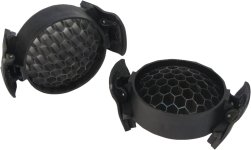If lens hoods are ineffective as you point out and I believe you, why do many people think they are effective like Binomania and Tobias. I trust they are making valid observations, and they are very experienced with binoculars, so it baffles me who to believe.The image below shows how effective the device actually is when it's installed as shown in the website photo.
I used the front of the internal reflection area in an 8x42 NL as a reference point for how far into the binocular interior the sunshade's shadow must penetrate to be effective. As you can see by following the green string the line between shaded and unshaded follows a 32.5º angle toward the 12:00 position above the binocular and that is the very best this device can do since its length is shorter in all other directions. I would say it would have essentially no effect on the 8x42 NL in directions below 2:00 and 10:00 compared to no sunshade at all and no effect even at its maximum length on light arriving from less than 32.5º above the binocular.
Trying to control glare by shading from the front seems like a reasonable idea until you begin to look at its limitations. By far the best way to tame the glare in the NLs is to the find an eyecup length that works, so that the glare is blocked internally between where it originates and the eye. If you can bring your eyes close enough to the eyepieces to see kidney beaning then you can reach the glare free spot because it's just behind that point. Your eyes went right past it on their way to seeing the kidney beaning. Even Dennis could do it if he wanted. Probably only a few eyeglass wearers with thick lenses and frames and deep set eyes might not be able to get their pupils close enough to the eyepieces.
Trying to control glare by having to adjust the eye cup length within a mm is overly tedious. No normal person is going to want to do that. They are going to try the 6 click stops that Swarovski has designed into the binoculars and if they still see glare they are going to give up.
Besides, if you adjust the eye cups between the click-stops, you have a chance of moving them when you push your eyes up against them. Swarovski needs to redesign the NL's, so eye cup length is not as critical in avoiding glare.









